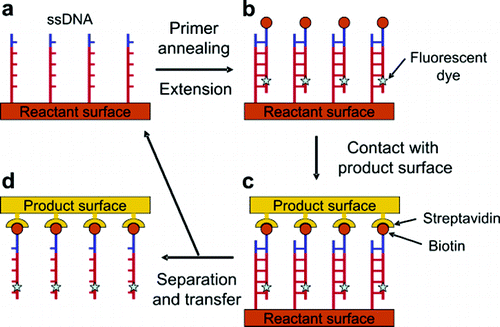댓글 쓰기 권한이 없습니다. 로그인 하시겠습니까?
Transfer of surface polymerase reaction products to a secondary platform with conservation of spatial registration
| Journal | J. Am. Chem. Soc. |
|---|---|
| Author | Kim, J.; Crooks, R. M. |
| Citation | J. Am. Chem. Soc., 2006, 128, 12076-12077 |
| DOI | https://doi.org/10.1021/ja0646139 |

Here, we describe a method for directly transferring very small amounts of reaction products from one surface to another. The approach is illustrated using a T4 DNA polymerase reaction to extend primers hybridized to a surface-confined DNA template. Following the extension reaction, the resulting oligonucleotide is transferred to a product surface. The important results are that (1) the spatial registration of the product is preserved after transfer; (2) the same reactant surface can be used to generate and transfer multiple iterations of products; and (3) the reaction products are biologically active after transfer.
-
Hybridization of DNA to bead-immobilized probes confined within a microfluidic channel
-
Transfer of surface polymerase reaction products to a secondary platform with conservation of spatial registration
-
Replication of DNA microarrays from zip code masters
-
Parallel fabrication of RNA microarrays by mechanical transfer from a DNA master
-
Replication of DNA microarrays prepared by in situ oligonucleotide polymerization and mechanical transfer.
Designed by sketchbooks.co.kr / sketchbook5 board skin
Sketchbook5, 스케치북5
Sketchbook5, 스케치북5
Sketchbook5, 스케치북5
Sketchbook5, 스케치북5
.png)


 Hybridization of DNA to bead-immobilized probes c...
Hybridization of DNA to bead-immobilized probes c...
 Replication of DNA microarrays from zip code maste...
Replication of DNA microarrays from zip code maste...



